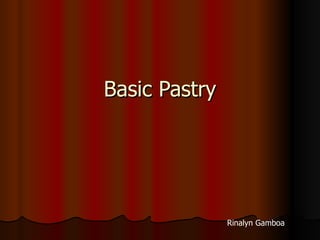Basic pastry
- 1. Basic Pastry Rinalyn Gamboa
- 2. Pastry comes from the word âpasteâ â a mixture of flour, liquid and fat In bakeshop, it refers both to various pastes and dough Ex: puff pastry ( p â te feuilletée ) & éclair paste ( p âte à choux )
- 3. P â te Brisée Pronounced as âpot bree zayâ â broken dough Mixed the same way as pie dough or creaming method Used for large tarts
- 4. Procedure Sift flour, salt and sugar Cut butter in small cubes. Rub into flour until it look like fine breadcrumbs. Make a well at the centre Mix egg, water and other liquid ingredients. Pour in flour. Mix to form soft dough Knead gently until smooth and well blended Wrap in plastic film and chill for at least 30 minutes before use
- 5. Procedure (creaming method) Cream together butter, sugar and vanilla until the mixture is smooth and pale Add egg one at a time, beating well after each addition Add the flour. With a plastic scraper, carefully blend into a soft dough Wrap in plastic film and flatten out. Chill until firm before use
- 6. Puff Pastry Rich, buttery dough that bakes into hundreds of light crispy layers Rolled-in dough like danish and croissant dough but no yeast content Steam serve as the leavening agent; can rise to eight times to its original thickness when baked Butter is the preferred fat for rolling in
- 7. Procedure for making Puff Pastry Dough
- 8. 1. Make a well in the mound of flour and add the liquid
- 9. 2. Work the ingredients into a dough
- 10. 3. Knead the dough until smooth. Refrigerate for 30 mins. Then roll it out into a large rectangle
- 11. 4. To prepare the butter, first soften it by beating it with a rolling
- 12. 5. Square off the butter. Roll it into a smooth rectangle two-thirds the size of the dough rectangle
- 13. 6. Place the butter on the dough so it covers the bottom two-thirds of the rectangle
- 14. 7. Fold down the top, unbuttered third of the dough so it covers half the butter
- 15. 8. Fold the butter third over the center. The butter is now enclosed.
- 16. 9. To give the dough its first four fold, roll the dough into a long rectangle. Before rolling, beat the dough lightly as shown so that the butter is evenly distributed
- 17. 10. Before folding, always brush off excess dusting flour
- 18. 11. Fold down the top edge of the dough to the center
- 19. 12.Fold up the bottom edge to the center
- 20. 13. Fold in half to achieve the finished four fold
- 21. Ìı
- 22. Alternative Method: Enclosing the Butter in Puff Pastry
- 23. 1. Roll the dough into a blunt cross shape as shown, leaving the center thicker than the arms of the cross
- 24. 2. Place the square of the butter in the center. Fold one of the arms of dough over the center
- 25. 3. Fold the remaining three arms of dough oven the center
- 26. Guidelines for Make up and Baking of Puff Dough Products
- 27. Dough should cool and firm when it is rolled and cut Cut with a straight, firm even cuts Avoid touching the cut edges with the finger, layers may stick together Place units upside down on baking sheets Avoid letting the egg wash run down the edges
- 28. 6. Rest made up products for 30 minutes or more in a cool place before baking 7. Trimmings may be pressed together, keeping the layers in the same direction 8. Baking temperature of 400 ° to 425 °F (200 ° to 220 °C) are best for most puff dough products
- 29. Puff Pastry Faults and their Causes Too much fat used Not even turns given Oven too cool Fat running out during baking Improper rolling in procedure Uneven distribution of fat before rolling Dough not relaxed before baking Uneven heat in oven Uneven lift or irregular shapes Too little or too little fat used Dough rolled out too thin or given too many turns Oven too hot or too cold Poor lift or rising Dough not relax during baking Shrinkage during baking Possible Causes Faults
- 30. Ãclair Paste (Choux Paste) Is leavened by steam and is used to make é clairs and cream puffs P â te à choux â âpot a shooâ Golden brown, crisp pastry with an almost empty interior Unique because the dough is cooked before it is baked Dough is piped into shape before baking It should be firm enough to hold its shape when piped from a pastry bag
- 31. Procedures: Bring the liquid, fat , salt, and sugar to a boil.
- 32. Procedures: 2 . Add the flour all at once and still until the paste forms a ball and pulls away from the sides of the pan. 3. Remove the paste from the heat, let it cool to 140 °F(60°C)
- 33. 4. Beat in the eggs a little at a time The paste is now ready to used Procedures:
- 34. Procedures: 6. Place in pastry bag and piped onto parchment paper lined pan 7. Bake at 220 °C(425°F) for first 15 minutes. Reduce to 375°F(190°C) to finish baking Note: if they are removed too soon on oven or cooled too quickly, they may collapse
- 35. Chocolate Ãclairs Using a piping bag to fill the éclairs with pastry cream. Chocolate Ãclairs Dipping the éclairs in chocolate glaze.
- 36. Meringue Egg whites whipped with sugar The texture, hard or soft, depends on the amount of sugar added Can be used to create baked meringues and cookies or to top pies and other baked goods
- 37. Meringue




































